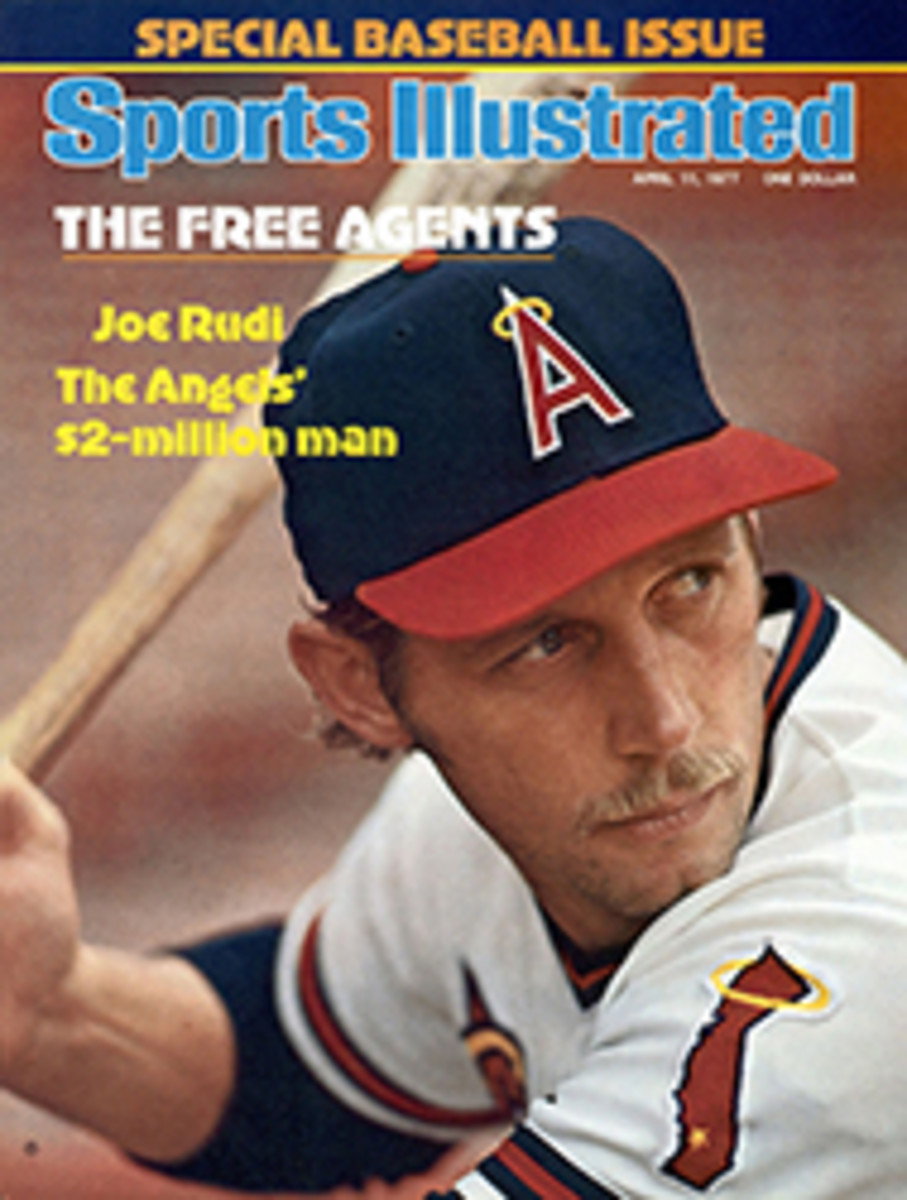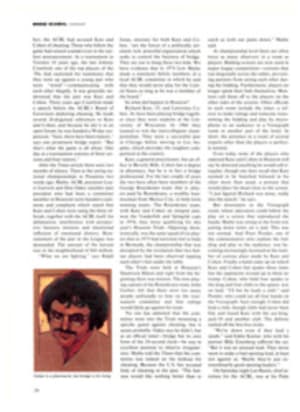
The East
There is a new photograph hanging in the home team's clubhouse at Yankee Stadium. It was taken last October and shows Pete Rose in a New York cap with his thumbs pointing downward. The picture, of course, is supposed to serve as a goad to the Yanks, who were swept by Rose's Reds in the '76 World Series. "This year we want to go all the way," says a New York team official, "to show we can play with Cincinnati." Indeed, to hear the Yankees tell it, winning their division and the American League pennant will be a snap, and the only confrontation likely to test their mettle would be a rematch with the despised Reds.
The Yanks may be right. On paper they look like a baseball version of the Philadelphia 76ers. Last season New York won its division by 10½ games and had a surplus of good pitchers, outfielders and designated and left-handed hitters. Over the winter the Yankees plucked the plums of the free-agent draft, Pitcher Don Gullett, 11-3 with the '76 Reds, and left-handed Outfielder Reggie Jackson (.277, 27 homers and 91 RBIs as an Oriole). Where are they going to play all those guys?
Gullett will join the rotation of Catfish Hunter (17-15), Ken Holtzman (14-11), Ed Figueroa (19-10) and Dock Ellis (17-8). Yankee pitching was the best in the league (3.19 team ERA), and Gullett will more than make up for the departure of Doyle Alexander to Texas. As good as all that sounds, questions remain. Is Ellis really a 17-8 pitcher, particularly after a spring spent in a bitter salary dispute? Can Hunter, who has shoulder problems, work regularly? In relief, Sparky Lyle was the leader in saves (23), but still wound up in Manager Billy Martin's doghouse. During spring training the Yankees tried to trade the disgruntled lefthander—and failed. Lyle's bullpen mates, Dick Tidrow and Ron Guidry, have never strung together two good seasons.
Jackson's bat will fit nicely into a modern-day Murderers' Row: Catcher and Most Valuable Player Thurman Munson (.302,17 homers, 105 RBIs), First Baseman Chris Chambliss (.293, 17 homers, 96 RBIs), Third Baseman Graig Nettles (93 RBIs, a league-leading 32 homers), Leftfielder Roy White (.286 and a league-leading 104 runs) and Second Baseman Willie Randolph (.267,37 stolen bases). Jimmy Wynn and Ron Blomberg lead a cast of thousands available for DH. But Jackson's personality and $300,000 salary may not suit the other Yankees. Munson and Nettles have barely concealed their animosity toward him.
Surprisingly, New York's biggest problem may be moody Centerfielder Mickey Rivers, the catalyst of last season's attack. Though he batted .312 and had 43 steals, the front office was unimpressed with their leadoff man's 13 walks. Rivers, hardly baseball's smartest player, grumbled at the idea of learning to take pitches this spring. And if opposing third basemen play him as tightly as Rose did in the Series (when Rivers hit .167), he may have to revamp his swing, too. Mick isn't quick enough to steal first. Or of a temperament to accommodate many changes in his style of play.
But more than anything, opponents are counting on a slow Yankee start. Then, they say, the explosive Martin will get caught in a vise of volatile personalities—Owner George Steinbrenner in the front office; Jackson, Munson, Ellis, Rivers and Lyle in the clubhouse. Unless General Manager Gabe Paul proves to be a Kissingerian mediator, the theory goes, the team will suffer. Think again, theorists—the Yankees play 13 of their first 22 games against weak teams from Toronto, Milwaukee and Seattle.
Nonetheless, New York is unlikely to run away with the division. Remember, the Red Sox were at least as heavily favored to repeat in 1976 as the Yankees are in 1977, yet the Sox slumped to third, 15½ games behind. Boston's holdovers can be expected to do a little better this season, and the Sox can only be enhanced by the signing of Fireman of the Year Bill Campbell (17-5,20 saves at Minnesota). Campbell will come in handy spelling Rick Wise (14-11) and Reggie Cleveland (10-9), who are still trying to dispel their images of being superannuated .500 pitchers, and Bill Lee (5-7), who has not regained his breaking stuff following shoulder surgery. Not even Luis Tiant (21-12) can be counted on as a stopper. He was 5-9 against first-division clubs. The best pitching news has been the return to form of Ferguson Jenkins (12-11), whose career was feared to be over because of a torn Achilles tendon.
Boston hit a league-leading 134 homers and will be even more powerful now that George Scott (.274, 18 homers, 77 RBIs) has returned from his five-year hiatus in Milwaukee. An excellent first baseman, Scott will scoop up the all-too-often errant throws of Second Baseman Denny Doyle, Shortstop Rick Burleson and Third Baseman Butch Hob-son. The Red Sox wanted Scott so badly they were willing to put up with the consequences, which include moving Centerfielder Fred Lynn (.314), who will miss the first couple of weeks of the season because of an injury, to the second spot in the batting order and creating a nasty battle for left field between Carl Yastrzemski (.267, 21 homers, 102 RBIs) and Jim Rice (.282, 25 homers, 85 RBIs). They may wind up splitting time between left field and DH.
Cleveland finished above .500 (81-78) last season for the first time since 1968 and is much improved. Wayne Garland (20-7 at Baltimore) and Al Fitzmorris (15-11 at Kansas City) have joined Jim Bibby (13-7), Dennis Eckersley (13-12) and Pat Dobson (16-12) in the starting rotation. A good sinker-bailer, Garland can expect plenty of help from Third Baseman Buddy Bell, Shortstop Frank Duffy and Second Baseman Duane Kuiper, who are death on ground balls. But Fitzmorris may not get the assistance he needs. He has relied on good hitting to win 59% of his career decisions, and Cleveland has a Punch-and-Judy attack. Last year the Indians slumped from 153 to 85 homers—then sent George Hendrick and his 25 taters to San Diego. Among the returnees, only 36-year-old Rico Carty had more than 10.
The Indians have one of baseball's top right-left relief combinations in Jim Kern and Dave LaRoche, who combined for 36 saves. Bell (.281), Centerfielder Rick Manning (.292) and Leftfielder John Grubb (.284) all have the potential to be .300 hitters. But a lack of depth and power should hold the Indians back.
For the first time since 1967, Baltimore has no chance to win anything. Pitcher Mike Cuellar has been waived, Centerfielder Paul Blair traded, Third Baseman Brooks Robinson demoted to player-coach, and Jackson, Garland and Second Baseman Bobby Grich lost to free agentry. Even the last grand link to the glory days, three-time Cy Young Award winner Jim Palmer (22-13), is dissatisfied. "The whole situation is distasteful." he says.
His teammates undoubtedly agree. Still around are Shortstop Mark Belanger, who won his fifth Gold Glove, and First Baseman Lee May, who led the league with 109 RBIs. This season clean-up hitter May will not see many fastballs, because there is no strong hitter batting behind him. To finish a respectable fourth, the Orioles need old, possibly irretrievable form from Rudy May (11-7) and Ross Grimsley (8-7), Rookie-of-the-Year batting from Rich Dauer (.336 at Rochester) and improved offense from fellow infielder Doug DeCinces (.234).
There is a changing of the guard in Detroit, too. Recently the old men of the majors, the Tigers now have only four players who were with them in 1973. Nonetheless, the team last year resembled a veterans hospital. At various times six mainstays were disabled. Still, the Tigers improved their record by 17 wins, the biggest jump in the majors.
The team is most blessed in the outfield, where rookie Steve Kemp (.386 in Triple A), Ron LeFlore (.316. 30-game hitting streak, 58 stolen bases), Ben Oglivie (.285). Willie Horton (.262) and Rusty Staub (.299, 15 homers, 96 RBIs) are available. Ideally, the Tigers would like to use the lead-footed Staub as their DH, but Horton is no silver streak either. The situation will resolve itself if Horton has his usual June injury after his usual spate of April homers.
Despite Mark Fidrych (19-9), who worked more than one-sixth of his club's innings and led the league in ERA (2.34) and complete games (24), the Tigers had the worst team-pitching in the division. The main hope for an improvement is rookie Dave Rozema, who struck out 96 and gave up only 15 walks in 126 innings at Montgomery.
Sal Bando, late of Oakland, has reported to Milwaukee as third baseman and head cheerleader. "This team is where the A's were in '69 and '70," he says. Maybe so, but the Brewers will have to depend on Bando (27 homers, 84 RBIs, with a .240 average) for most of the sock now that Scott and Henry Aaron are gone. Other newcomers include Cecil Cooper (.282, 15 homers, 78 RBIs at Boston), who replaces Scott at first, and Royal refugees Jamie Quirk at DH and Jim Wohlford in the outfield. Shortstop Robin Yount is a three-year veteran at 21, and Sixto Lezcano (.285) is hot off a Puerto Rican League batting title. The bullpen (Bill Castro, Ed Rodriguez) and catching (Charlie Moore, Larry Haney) are adequate. Jim Slaton (14-15). Bill Travers (15-16) and Jerry Augustine (9-12) lead a children's crusade to the mound. "If you didn't know the club, you'd say, 'Hey, no chance.' " says Bando. Hey, no chance.
Toronto has sold an expansion-club record of 8,000 season tickets, which indicates its fans are eager for baseball. That they'll get, but not many wins. Shortstop will be shared by Bob Bailor, a former Oriole farmhand who has virtually no experience as a major-leaguer, and Jim Mason, who has never been mistaken for one. But there is depth at catcher (Alan Ashby, Rick Cerone, Phil Roof), good speed in the outfield (Gary and Ai Woods, Steve Bowling) and a promising rookie first baseman in Doug Ault. The best pitcher is Bill Singer, who wins 20 games every four years, most recently in 1973. The most popular player is 38-year-old Ron Fairly, who delivered the key hit in Toronto's 3-2 win in its first exhibition game with Montreal.
Thus distinguished, the Blue Jays say they are no longer interested in merely topping Montreal's first-year record of 52 wins. "If you're convinced you'll win 60, you're convinced you'll lose 102," says Manager Roy Hartsfield. He'll be lucky if he does that well.
PHOTO
Yanks have 'em by the Gullett
Why in the name of Red Ruffing would the Yankees, who already had the American League's best pitching and one of the world's biggest payrolls, shell out $2 million to sign a guy who won only 11 games last year and ended the season with his leg in a cast? That's easy. The pitcher's name is Don Gullett. To be sure, Gullett has had only 26 victories the last two seasons, during which he missed 20 starts because of injuries, but he also lost just seven games. After seven big-league years, all with the Reds, he has the best won-lost percentage (.684) among active pitchers. And Gullett is very active these days; the various ailments that limited his appearances in '75 and '76, including the tendon he dislocated in his right ankle while pitching the Reds to victory over the Yankees in the World Series opener last fall, seem healed. Other enticements for New York were Gullett's age—he's all of 26—and his left-handedness. Even today's modified Yankee Stadium still has enough vast spaces in left field that it seems as if it were designed by a lefty pitcher. Fastballer Gullett should be a big winner there, and the Yankees may need his victories; their only other left-handed starter, Ken Holtzman, seemed to be fading at the end of last season, and their ace, Catfish Hunter, suffers from a chronically sore shoulder.

